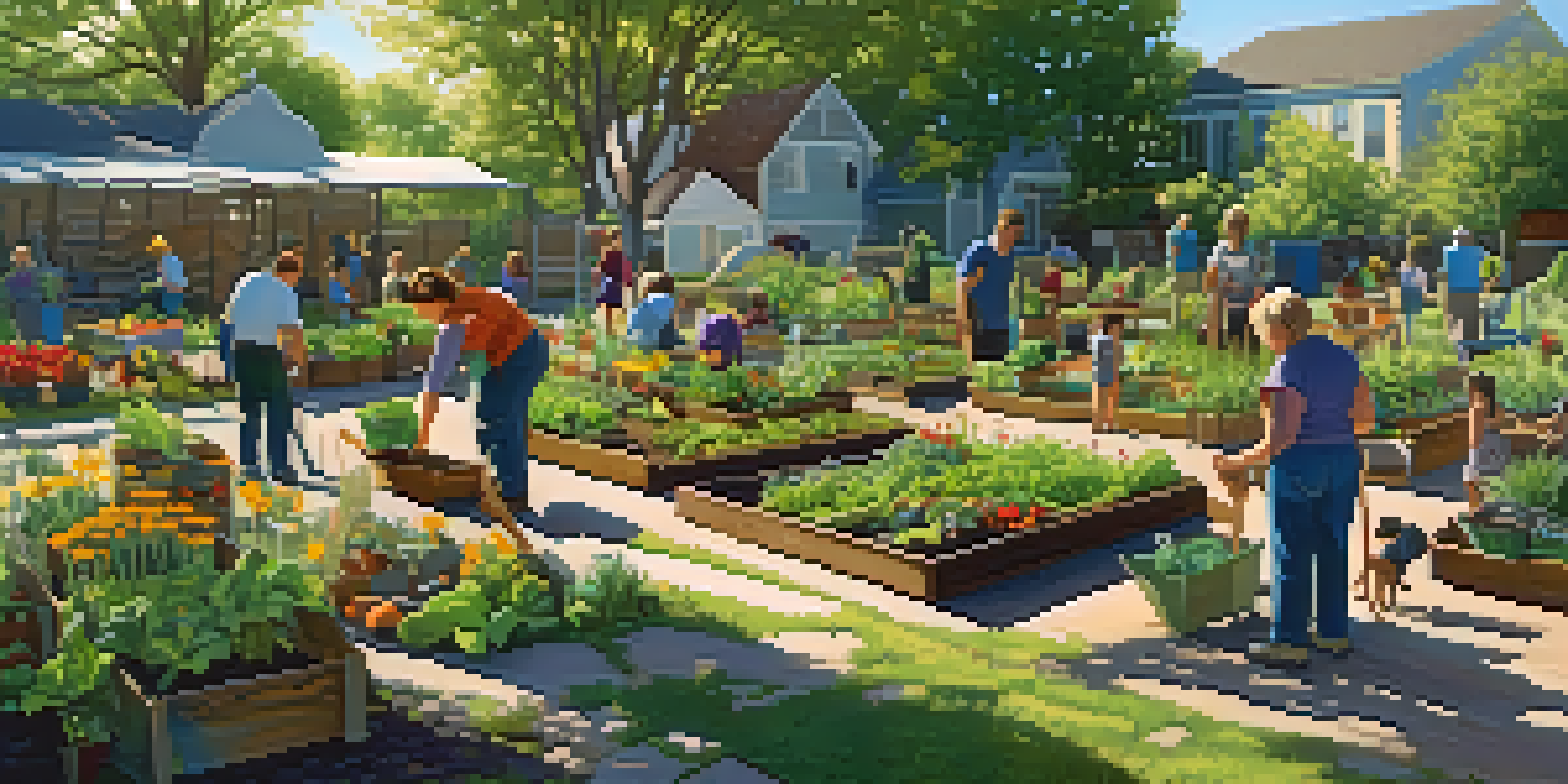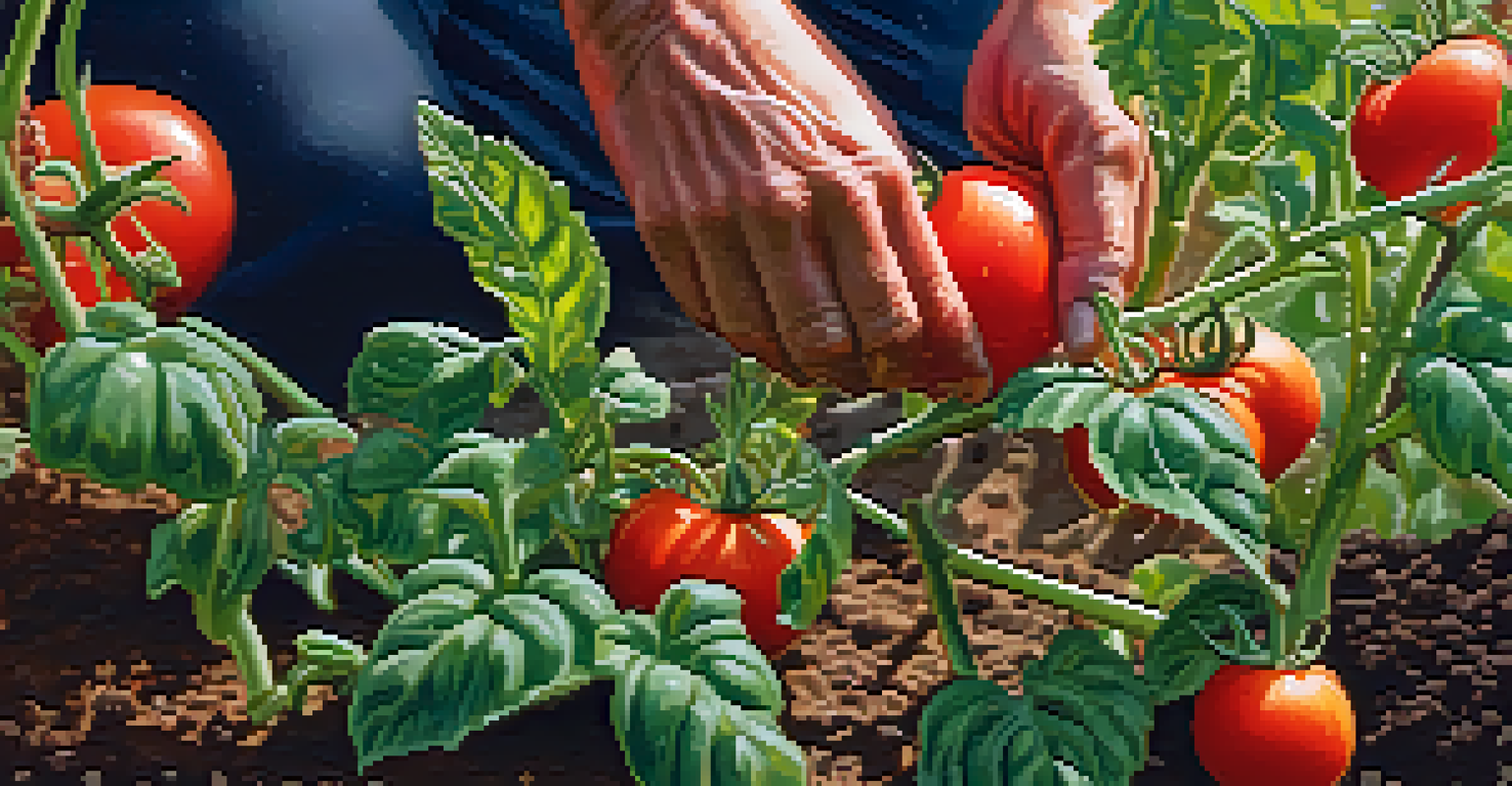Creating a Sustainable Community Garden in Your Neighborhood

Understanding the Benefits of Community Gardens
Community gardens offer numerous benefits, ranging from fresh produce to enhanced community ties. They provide a space where neighbors can come together, share knowledge, and cultivate a sense of belonging. Additionally, these gardens promote biodiversity and help combat urban heat, making our neighborhoods more livable.
Community gardens are a way to bring people together and create a sense of belonging in the neighborhood.
Imagine walking through your neighborhood and seeing vibrant gardens bursting with vegetables and flowers, where once there was only concrete. This transformation not only beautifies the area but also provides a sustainable source of food. Community gardens can even improve air quality and support local wildlife, creating a healthier environment for everyone.
Moreover, community gardens can serve as educational platforms. They offer hands-on learning experiences about agriculture, nutrition, and sustainability. Whether it’s a school field trip or a weekend workshop, these gardens can inspire people of all ages to appreciate and engage with nature.
Gathering Community Interest and Support
The first step in creating a community garden is to gauge interest among your neighbors. Hosting an informal meeting at a local park or community center can be a great way to spark conversations about the potential garden. Bringing everyone together helps build excitement and allows you to understand what people want from the garden.

Consider creating a simple survey to gather input on preferences, such as what types of plants people would like to grow or how often they can volunteer. This information is invaluable as it ensures that the garden reflects the community's desires and needs. Plus, when people feel involved from the start, they’re more likely to commit to the project.
Community Gardens Foster Connections
These gardens bring neighbors together, enhancing community ties and fostering a sense of belonging.
Once you have a solid group of interested neighbors, you can form a garden committee. This team can help organize meetings, manage tasks, and maintain communication. A dedicated group not only shares the workload but also fosters a sense of ownership and accountability.
Choosing the Right Location for Your Garden
Location can make or break your community garden. Look for open spaces that receive plenty of sunlight, have good drainage, and are easily accessible. Parks, schoolyards, or even vacant lots can serve as potential sites, but make sure to get permission from property owners or local authorities before proceeding.
Gardening adds years to your life and life to your years.
Think about the demographics of your neighborhood as well. Is there a lot of foot traffic? Will people feel safe visiting the location? A garden in a visible, well-trafficked area can create more interest and encourage participation. It’s all about making the garden a welcoming space for everyone.
Also, consider the soil quality and any potential contaminants. Testing the soil is crucial to ensure it’s safe for growing food. If the soil isn’t ideal, raised garden beds with quality soil can be a perfect solution, allowing you to control the growing conditions better.
Designing Your Community Garden Layout
Once the location is secured, it’s time to design your garden. Think about how you want to organize the space. Will there be individual plots for members, or will it be a collective garden where everyone contributes to the care and harvest? Having a clear layout makes it easier for everyone to understand their roles.
Incorporating pathways is also essential. They allow easy access for maintenance and harvesting while preventing soil compaction. Don’t forget to include communal spaces for gatherings, such as picnic tables or benches, where gardeners can share stories and enjoy their hard work together.
Location is Key for Success
Choosing a well-situated, accessible area with good sunlight and soil quality is crucial for a thriving community garden.
Consider adding elements like compost bins or rainwater collection systems to promote sustainability. These features not only reduce waste but also demonstrate eco-friendly practices in action, inspiring others in the community to adopt similar habits.
Securing Resources and Funding for the Garden
Starting a community garden often requires funding for tools, seeds, and other materials. Look into local grants, crowdfunding, or even sponsorships from local businesses. Many organizations are eager to support community initiatives, especially those focused on sustainability and health.
Consider hosting fundraising events like bake sales, plant sales, or community dinners. These events not only raise money but also strengthen relationships within the community. Plus, they provide an opportunity to share your vision and goals for the garden, encouraging more people to get involved.
Don’t overlook the power of donations. Many local gardeners may have spare seeds, plants, or gardening tools they’re willing to contribute. Reach out to your network and see what resources you can gather before purchasing new supplies.
Establishing Rules and Responsibilities
To ensure the smooth operation of your community garden, it's vital to establish clear rules and responsibilities. This might include guidelines on plot maintenance, watering schedules, and how to handle disputes. Having a written agreement can help set expectations and minimize misunderstandings.
Assigning roles within the committee, like a treasurer or a communications officer, can also streamline operations. This division of labor allows for accountability and ensures everyone knows their responsibilities. Plus, it helps distribute the workload, making the garden more manageable and enjoyable for everyone involved.
Sustainability Ensures Longevity
Focusing on sustainable practices and community engagement helps maintain enthusiasm and ensures the garden's success over time.
Regular meetings can help keep members engaged and informed. These gatherings provide a platform for discussing issues, sharing successes, and planning future activities. Open communication fosters a sense of community and encourages ongoing participation.
Promoting the Garden and Encouraging Participation
Once your community garden is up and running, it’s time to spread the word! Use social media platforms, local newsletters, and bulletin boards to share updates, events, and volunteer opportunities. Creating a dedicated social media page can help keep everyone informed and engaged.
Consider hosting open garden days where community members can come to tour the garden, participate in workshops, or simply enjoy the space. These events can build excitement and encourage others to get involved, whether they’re seasoned gardeners or just curious onlookers.

Engaging local schools can also be a great way to promote your garden. Organizing field trips or educational workshops can inspire the next generation of gardeners while fostering community connections. Plus, kids often bring their families along, expanding your garden’s reach even further.
Sustaining Your Community Garden for the Long Term
To ensure the long-term success of your community garden, it’s crucial to focus on sustainability. This means continuously nurturing not only the plants but also the community spirit that drives the garden. Regularly scheduled events, like harvest festivals or seasonal planting days, can keep enthusiasm high.
Encouraging rotating leadership within the garden committee can also infuse fresh ideas and energy into the project. New perspectives can help address challenges creatively and keep the garden aligned with community needs. Plus, it gives more people a chance to take ownership and feel invested in the garden's success.
Lastly, be open to feedback and adapt as necessary. Communities evolve, and so should your garden. By remaining flexible and responsive to the changing needs of your neighborhood, you can ensure that your community garden thrives for years to come.